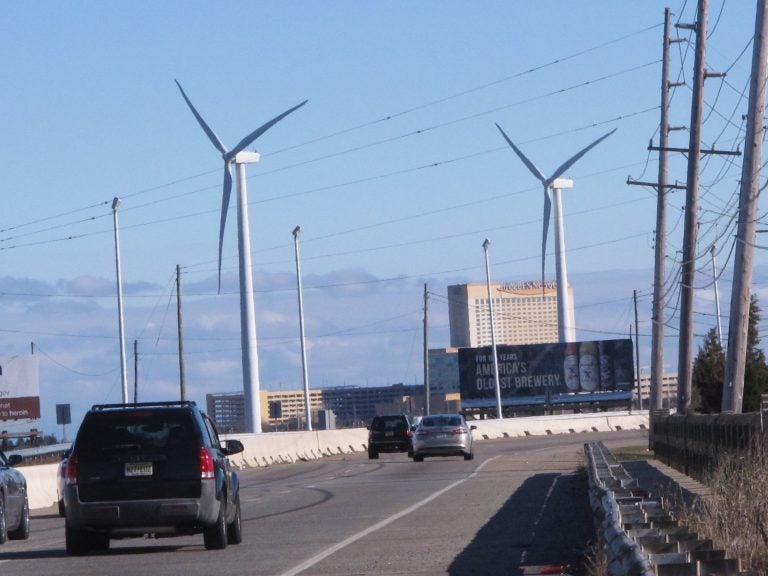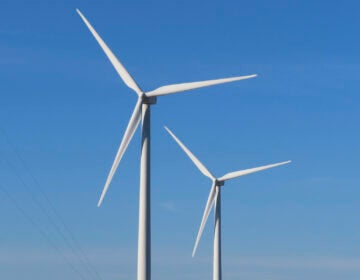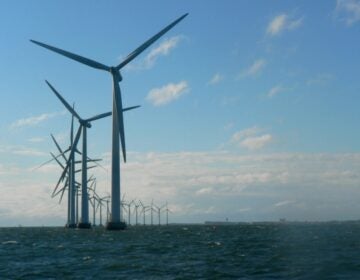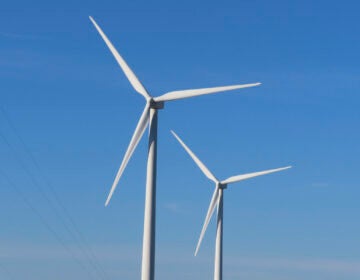Offshore-wind developers, N.J. officials won’t reveal key details of proposals
Three developers are vying to build offshore-wind farms aimed at achieving the Murphy administration’s goal of building 1,100 megawatts of capacity off the Jersey coast.

Cars drive past windmills on the grounds of a sewage treatment plant in Atlantic City, N.J. on Monday Jan. 4, 2016. (Wayne Parry/AP Photo)
Three developers are vying to build offshore-wind farms aimed at achieving the Murphy administration’s goal of building 1,100 megawatts of capacity off the Jersey coast in a process that is emerging as increasingly opaque.
Details of the projects, to be subsidized by potentially billions of dollars from electric customers in New Jersey, were not forthcoming from either the state Board of Public Utilities nor the developers.
The proposals were submitted by Ørsted US Offshore Wind, Equinor, and EDF Renewables North America/Shell New Energies. Newark-based Public Service Enterprise Group has an option to become an equity investor in Ørsted’s Ocean Wind project.
In fact, the BPU declined to identify the three bidders who submitted applications in a press release announcing what it described as regaining New Jersey’s place as a “leader when it comes to clean renewable energy and offshore wind power.’’
Asked to supply further details about the projects in emails and phone calls, Peter Peretzman, a spokesman for the agency responded, “We are not sharing additional formation at this time.’’
Later last evening, Samantha Levine, BPU’s director of communications added this: “In short, the OSW solicitations are being treated as a competitive deliberative process and we will therefore not be releasing the complete applications or any confidential, proprietary information.”
New Jerseyans already pay high energy bills
Offshore wind has been a top priority of Gov. Phil Murphy who campaigned on a pledge to develop 3,500 MW of wind capacity off the coast, the nation’s most aggressive target for the relatively new industry in the U.S. Only one small offshore-wind farm is operating in the U.S., owned by Ørsted, one of the bidders in New Jersey.
The Murphy administration’s offshore-wind goals have won strong backing from the environmental community and others concerned about climate change, particularly because of the latter’s potential impact on a coastal state like New Jersey.
But some business interests worry that a huge commitment to offshore wind will spike already high energy costs in a state which traditionally ranks among the top ten for energy bills.
“We are talking about large impacts on ratepayers,’’ said Dennis Hart, executive director of the Chemistry Industry Council of New Jersey, referring to the costs of subsidizing the offshore-wind projects under a decade-old law signed by former Gov. Chris Christie. “Anytime they do that, they need to be as transparent as possible.’’
The offshore-wind law provides that ratepayers will subsidize the development of the wind farms built off the coast by a surcharge on customers’ monthly bills. Revenue generated by the electricity from the wind turbines will be returned to customers. The precise cost of the surcharge will be determined over the next six months or so by the BPU.
Because of the competitive nature of the process set up by the state, developers were wary of providing much information about their proposals. Ørsted plans to build its project 15 miles off Atlantic City, while EDF’s proposed development would be located about eight miles from the resort. Equinor’s project is 20 miles east of the Monmouth County coast, and 15 miles south of Long Island.
‘Price is confidential’
“Can’t say much other than what’s in there for now,’’ texted Lauren Burn of Ørsted, when asked about the project. “Price is confidential as we are still in a competitive process. Size will be determined on what the BPU solicits for mw.’’
In its solicitation request, the agency asked developers to outline their proposals on the timing and scale of the projects. In previous public comments, Ørsted indicated it would like to build more than 1,000 MW to take advantage of economies of scale. The company has a pipeline of projects in other states; it also has one in the pipeline off Cape May, for which it did not submit an application.
Erin Dennis, a spokeswoman for EDF, could not provide additional details about the scope and timing of the company’s project, which is called Atlantic Shores Offshore Wind, LLC. Equinor, a division of a Norwegian energy company, declined to provide any details about its proposal, Boardwalk Wind.
The lack of transparency about the offshore-wind projects is not a new development.
EDF had sought to build a small pilot offshore-wind project (25-MW) three miles from Atlantic City, but the BPU rejected that proposal last month. In denying approval, the agency said it would prove too costly to ratepayers and had failed to prove that it would be a net economic benefit to the state.
Concern about transparency
But the BPU declined to reveal how much the proposed surcharge, dubbed an Offshore Renewable Energy Certificate (OREC), would have cost ratepayers under EDF’s proposal.
By some estimates, the cost of developing utility-scale offshore wind projects of the scope of those now before the BPU will easily top $1 billion.
Even some proponents of offshore wind, while welcoming that large-scale projects are now under consideration, also expressed concerns about the transparency of the process. “Our concern is that it’s about as clear as the water in Newark Bay,’’ said Jeff Tittel, director of the New Jersey Sierra Club.
The board is expected to decide on what projects, if any, move forward this spring, a step that needs to be taken if the proposals are to qualify for a lucrative federal tax credit that’s due to expire by the end of 2019.
WHYY is your source for fact-based, in-depth journalism and information. As a nonprofit organization, we rely on financial support from readers like you. Please give today.




